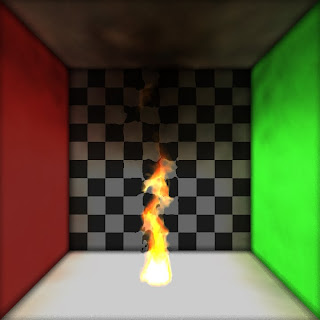Thermal refraction is a naturally occurring optical phenomenon in which light rays bend due to rapid differences in temperature and composition of participating media. The resulting images show characteristic "shimmering" and rapid local intensity fluctuations and heat advection.
This secondary effect provides important visual cues to enhance a scene's realism when lit by firelight. We proposea physically based technique for animating thermal refraction attributable to large changes in temperature due to fire, heat and smoke. A key contribution of our method is an automatic approach to correctly vary the reflective index around exothermic thermal phenomena and change the spectral properties due to absorption and scatter effects. We present a novel volumetric photon mapping method which treats both the flame and smoke as light sources: photons are emitted based on both smoke and fire energy levels.
Our method extends volumetric rendering by a physically derived model to ray march voxels to account for the optical properties of participating gas and flame. The time varying photon maps produce the fluctuating illumination on scene surfaces and caustics. Using this physically
based rendering technique, we generate realistic fluctuations in light distribution and refractive distortion effects due to fire, smoke, and hot particles. Lastly, we compare our work to previous
approaches to show how modeling the whole thermal event produces a more realistic simulation.
based rendering technique, we generate realistic fluctuations in light distribution and refractive distortion effects due to fire, smoke, and hot particles. Lastly, we compare our work to previous
approaches to show how modeling the whole thermal event produces a more realistic simulation.
 rendered image with diffuse wall
rendered image with diffuse wall
rendered image with specular wall

rendered image with only schlieren effect
No comments:
Post a Comment